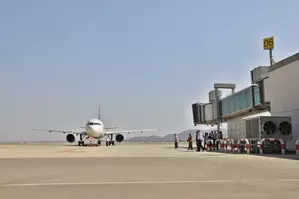Gwadar International Airport: A Gateway to Prosperity or a Symbol of Conflict?
The recently inaugurated Gwadar International Airport, a colossal project funded by China, stands as a beacon of ambition and a symbol of tension in Pakistan's restive Balochistan province. Is it a game-changer poised to propel economic growth, or a flashpoint fueling existing separatist conflicts? The answer, like the region itself, is complex and multifaceted. Let's delve into the details.
A $230 Million Investment in Regional Connectivity
Officially opened with much fanfare, the airport, constructed under China's Belt and Road Initiative (BRI), boasts a capacity to handle 400,000 passengers annually. This substantial infrastructure investment reflects the strategic importance of Gwadar as a key regional trade hub, complimenting the deep-sea port and providing unparalleled access to Central Asian markets. The airport can accommodate a wide variety of aircraft types, from ATR 72s to Boeing 747s, suggesting a keen focus on both domestic and international routes, promising opportunities for the growth of Pakistan International Airlines and other carriers. For travelers, the expanded capacity promises improved connectivity and more flight choices than ever before. This opens up doors for increased tourism, a major potential boon for the local economy, offering diverse options such as cultural tourism and adventure travel.
Economic Potential and Trade Links
The airport's strategic location offers unmatched connectivity to multiple markets and routes, thereby reducing transportation costs and time and fostering regional and global trade. This directly translates to creating job opportunities and business ventures. Improved accessibility boosts investment, promising new employment opportunities, and thus addressing regional economic issues.
Enhancing Tourism Prospects in Balochistan
With its improved infrastructure and accessibility, the airport is also poised to propel growth in the tourism sector. Balochistan, a relatively unexplored area, boasts unique landscapes and cultural attractions. The influx of tourists could contribute substantially to economic prosperity by bolstering local industries and encouraging growth in hospitality and service sectors, increasing the local economy and giving a substantial lift to residents' lives.
Navigating Security Concerns and Political Challenges
The construction of Gwadar International Airport wasn't without its challenges. Balochistan has been rife with separatist movements and armed conflict for decades, adding substantial complications to construction. These insurgents have voiced strong opposition to Chinese investments, citing economic exploitation and lack of consideration for local populations. This conflict makes the airport’s success a delicate balance between progress and security. Ensuring the safety of passengers, employees, and infrastructure requires significant ongoing commitment to addressing these very real and dangerous challenges.
Addressing Separatist Concerns and Balancing Development with Local Needs
Critics claim development projects disproportionately benefit outsiders while ignoring the needs and concerns of local communities. Bridging this divide and establishing a constructive partnership between foreign investment and regional growth is absolutely paramount to lasting peace and successful development. The long-term success of the airport critically hinges on finding common ground, facilitating mutual benefit and promoting sustainable development which uplifts the lives of all people, creating lasting benefits and prosperity for the population as a whole.
Security Measures and Regional Stability
Stringent security measures must remain in place to safeguard the airport, and to assure both domestic and international travelers. While a robust security strategy protects against attacks and insurrections, its presence shouldn’t overshadow or limit access for all citizens. Maintaining security also depends on working toward a collaborative environment to promote stability within the region and provide security for its residents.
A Symbol of Deeper Pakistan-China Ties
Despite the ongoing conflict and separatist movements, the Gwadar International Airport signifies a deepening relationship between Pakistan and China. It underscores the strength of their diplomatic and economic ties and their collaborative efforts on regional economic development. The airport represents the substantial progress made in the China-Pakistan Economic Corridor (CPEC), a crucial initiative under China's Belt and Road Initiative, positioning Gwadar as a critical trading hub for increased commerce.
Regional Cooperation and Global Impact
Successful operation of the Gwadar airport will encourage further collaboration on infrastructural improvements throughout the region. This not only promises economic opportunities, but also enhanced cultural understanding between multiple regions. Ultimately, this global interconnectedness promotes cooperation on a broader international scale and advances prosperity across the region.
CPEC's Expanding Influence and Economic Growth
The airport is considered a milestone accomplishment in the continued growth of CPEC, further strengthening the regional position of both China and Pakistan, and promoting global trade and connectivity. Success of this venture would promote economic gains for years to come, building a greater level of interconnectivity and trade opportunities which serve as a significant step forward for all involved.
Take Away Points
The Gwadar International Airport represents a significant step toward improved regional connectivity. However, its ultimate success will depend on successfully addressing deep-seated security concerns and economic inequalities within the province of Balochistan. Only by tackling these issues, creating inclusive growth, and finding peaceful solutions can this ambitious infrastructure project realize its full potential. Careful balancing of national ambition with regional needs and security, are all critical for positive results in the years to come.









